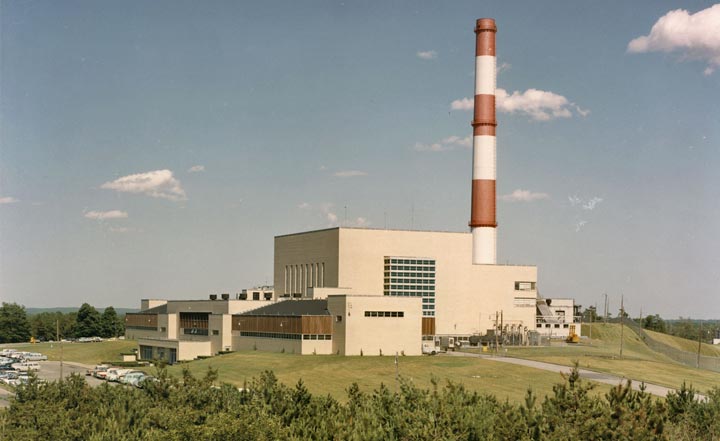Why Was the BGRR Decommissioned?
 The
Brookhaven Graphite Research Reactor (BGRR) at Brookhaven
National Laboratory (BNL) was decommissioned to ensure the complex
is in a safe and stable condition and to reduce sources of groundwater
contamination.
The
Brookhaven Graphite Research Reactor (BGRR) at Brookhaven
National Laboratory (BNL) was decommissioned to ensure the complex
is in a safe and stable condition and to reduce sources of groundwater
contamination.
The BGRR contained over 8,000 Curies of radioactive contaminants from past operations consisting of primarily nuclear activation products such as hydrogen-3 (tritium) and carbon-14 and fission products cesium-137 and strontium-90. The nature and extent of contamination varied by location depending on historic uses of the systems and components and releases, however, the majority of the contamination (over 99 percent) was bound within the graphite pile and biological shield.
Radioactive contamination was identified in the fuel handling system deep pit and canal, and in the steel and concrete within the below ground ducts. Extensive characterization performed determined that the reactor building exterior and interior structures, systems and components, with limited exceptions, were relatively free of contamination. However, because of leakage during and after reactor operations, contamination was also found in soil pockets located under certain BGRR structures including under/around the reactor building, within the below ground ducts, and within the canal. Groundwater monitoring downgradient of the BGRR indicated that the reactor complex was a source of strontium-90 groundwater contamination.
Decommissioning of the BGRR, including biological shield and graphite pile removal, was chosen to reduce the radiological footprint of the BGRR complex, control the sources of contamination to groundwater, and reduce the potential threat of additional release to the environment.
Safe, Secure Shutdown
Many planning studies, including engineering studies, a site investigation, facility characterization, and risk assessments were conducted. The BNL Environmental Restoration Projects managed the BGRR decommissioning. DOE and BNL worked with local, state, and federal regulatory agencies to develop the decommissioning plan. A Feasibility Study (PDF) and Proposed Remedial Action Plan (PDF) that outline final decontamination and decommissioning steps for the BGRR were prepared, and a Record of Decision (PDF) was approved in January, 2005.
From 1999 through 2012 many decommissioning actions were completed throughout the BGRR complex including dismantling of ancillary buildings in the BGRR complex; removal and disposal of contaminated soils; removal and disposal of the aboveground duct; removal and disposal of the biological shield and graphite pile; and installation of an engineered cap. Learn more about the clean-up actions.
The remaining BGRR buildings have been placed, and are currently being maintained, in a safe and stable condition. The BGRR complex was transferred to the Groundwater Protection Group in 2012 for long-term surveillance and maintenance of the complex. Learn more about the surveillance and maintenance activities.


